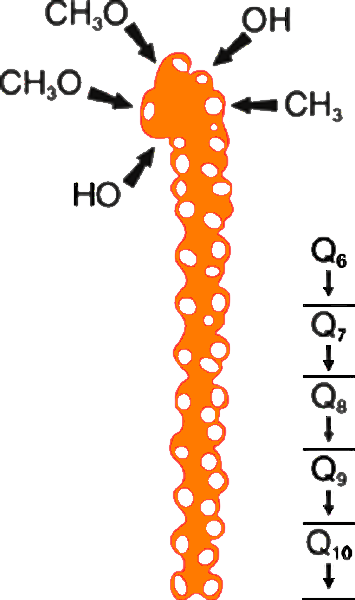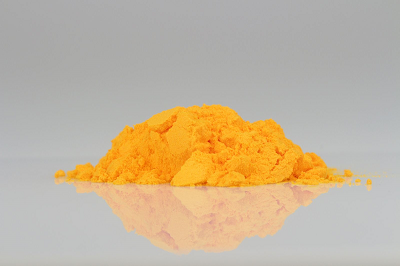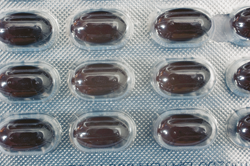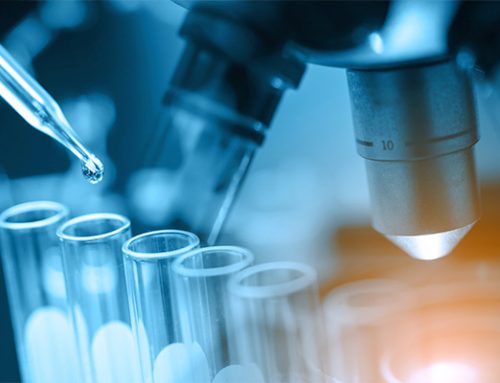
The Q10 molecule has a benzoquinone ring as its head and 10 isoprene repeats in its tail.
Its molecular formula is C59H90O4.
It seems that the discovery of Coenzyme Q10 was not an accidental discovery in the way that the discovery of penicillin was. A look at the history of Coenzyme Q10 reveals a determined progression of researchers toward greater understanding of the cellular mechanisms that produce energy in our cells.
To go back to the beginning, in 1954, Professor R. A. Morton and his colleagues in Great Britain carried out a number of studies on a mysterious lipid-soluble substance that they found everywhere in animal tissue, e.g. in the tissue of horse intestines, in the tissue of rat livers, and in the tissue of various organs in pigs (1). The British researchers got close, but they couldn’t quite identify the substance.
Q10 – The mysterious yellow stuff in the refrigerator
Three years later, then, in 1957, researchers at the University of Wisconsin were working on studies of the process of cellular energy production. One of the researchers was Assistant Professor Frederick Crane, a bio-chemist, who noticed some yellow crystals in a test tube containing material that had been recovered from the mitochondria in heart cells in beef cattle.
Dr. Crane used a technique called absorption spectroscopy to examine the yellow crystals, and he concluded that the mysterious crystals had to be quinones, which was puzzling because, up until that time, scientists assumed that only plants contained quinones (2).
Today, of course, we know that the quinones are biological substances with properties that are important for energy production in the human body. Vitamin K, for example, is also a quinone.
Q10 – the missing link in the production of energy
To get confirmation of his analysis of the yellow crystals, Dr. Crane sent a sample off to another bio-chemist, Dr. Karl Folkers, who was, at that time, working in the research labs at the pharmaceutical company Merck, Sharpe, and Dohme in New Jersey.
Dr. Folkers and his team confirmed that the substance was, in fact, a quinone, and the Merck team succeeded in identifying the chemical structure of the substance: trans 2,3, dimethoxy-5-methyl-6-decaprinyl-1,4-benzoquinone.
We now know that Q10 can exist in three oxidation states:
- As the fully oxidized ubiquinone (CoQ)
- As the radical semiquinone (CoQH)
- As the fully reduced ubiquinol (CoQH2)
Q10 – a fairly large molecule
Dr. Donald E. Wolf and Dr. Karl Folkers reported the discovery of Q10 to the scientific community in 1958, but, since then, universally, Dr. Frederick Crane is given credit for the initial discovery. Professor R. A. Morton, in Great Britain, proposed the name ubiquinone, a melting together of the words ubiquitous and quinone, which was appropriate because the substance seems to appear nearly everywhere in cells and tissues.
The 1960s – using Q10 for clinical purposes for the first time
In the 1960s, researchers began to think about ways in which to use Coenzyme Q10 for therapeutic purposes, e.g. to use Q10 as a supplement to improve cellular energy production and to use Q10 as an antioxidant. Professor Yamamura in Japan was the first person to use Q10 with chronic heart failure patients.
The 1970s – mass production of Q10 and a Nobel Prize
In 1972, the Italian Q10 researcher Dr. Gian Paolo Littarru, working together with Dr. Karl Folkers, was able to show that heart disease patients have low concentration levels of Coenzyme Q10 (3).
Then, in 1974, a Japanese company succeeded in developing a yeast fermentation process that made it possible to produce large amounts of pure Q10 that is identical, chemically, to the Q10 that the human body synthesizes. The ready availability of Q10 at an affordable price led to an acceleration in the use of Q10 for therapeutic purposes in humans.
Next, in 1978, the English bio-chemist Dr. Peter Mitchell was awarded the Nobel Prize in Chemistry for his description, back in 1961, of Q10’s role in the electron transport chain and its role in the process of the pumping of protons across the inner mitochondrial membrane in living organisms, producing, in the end, ATP, from which the cells release energy.
The 1980s – clinical research with Q10 takes off
With more and more research into the absorption and bioavailability of Q10 and into the safety and the efficacy of Q10 in certain disease conditions, the body of knowledge about the substance began to grow. Q10’s role as an antioxidant – in addition to its role in the production of energy – became known.
In 1985, Dr. Per Langsjoen conducted the first double blind study of the effect of Q10 supplementation on heart disease. Dr. Langsjoen was able to demonstrate a statistically significant effect of Q10. Incidentally, in the same year, Dr. Per Langsjoen’s son, Dr. Peter Langsjoen, began his career as a cardiologist and a Q10 researcher.
The 1990s – Q10 commercially available to health conscious individuals
Coenzyme Q10 products came onto the market; however, then as now, consumers needed to be careful in their purchases because all Q10 products do not get absorbed equally well. In its raw form,Q10 is a fat-soluble crystalline substance with a very poor absorption. The Q10 crystals need to undergo a special heat pre-treatment before they are dissolved in vegetable oils and sealed in soft-gelatin capsules.
Q10 research in this period focused on deficiency conditions, on the development of better absorbed products, and on the effect of Q10 on various disease conditions. One small study of the use of high doses of a Q10 supplement with breast cancer patients did show promising results in this period (5). And, Q10 began to be described in medical textbooks.
Karl Folkers – father of CoQ10 research
Dr.Karl Folkers realized very early on that Coenzyme Q10 was very important for the cells’ production of energy, and he foresaw CoQ10’s importance in the prevention of disease (4). He called CoQ10 “the essential bio-nutrient.” He was often very critical of commercial Q10 products, especially those in powder form, that did not have a good absorption rate. He recommended CoQ10 dissolved in oils.
At the end of his life, Dr. Folkers received numbers awards and prizes for his research in various substances including Q10. He died in 1997 at the age of 91.
The 2000s – a breakthrough in the treatment of heart disease with Q10
As with other substances that cannot be patented and developed and sold for great profits, — zinc supplements for the prevention of prostate cancer come to mind – research into the use of Q10 as an adjunctive therapy for heart failure patients has been delayed by the failure of both the big pharmaceutical corporations and the National Institutes of Health to fund the necessary research.
Let’s face it. Large randomized, double blind, placebo-controlled clinical trials cost a lot of money, and the big for-profit pharmaceutical corporations seem, often, to be more interested in taking their short-term profits and in spending money on marketing than in promoting and supporting research in the public interest.
Fortunately, we do have the published results now of some very well designed and executed studies that show clearly that, compared with placebo, Q10 supplementation produces statistically significant health benefits.
The KiSel-10 study of Q10 and selenium in healthy elderly citizens
Researchers in Sweden carried out a well-designed four-year study of supplementation with Q10 and selenium – the two substances have a special interrelationship in the body – and found that healthy elderly adults taking the supplements could reduce their risk of dying from heart disease by over 50% compared with their peers who did not take the supplements (6).
The Q-Symbio study of Q10 for chronic heart failure patients
A well-designed multi-center international study showed that chronic heart failure patients who received 300 mg daily (100 mg three times a day) of a well-absorbed Q10 preparation in addition to their conventional heart disease medication had their risk of dying of heart disease reduced by 43% compared with similar patients who received only the conventional heart disease medication. Moreover, the patients receiving Q10 had their risk of dying of other causes reduced by 42% compared with the patients who got the placebo capsules (7).
Sources:
- Festenstein GN, et al. A constituent of the unsaponifiable portion of animal tissue lipids. Biochem J. Apr 1955; 59(4): 558–66.
- Crane FL. Discovery of ubiquinone (coenzyme Q) and an overview of function. Mitochondrion. 2007;7 Suppl:S2-7.
- Littarru GP , Ho L , Folkers K. Deficiency of CoQ10 in human heart disease. Int J Vitam Nutr Res 1972; 42: 291-5.
- Folkers K, et al. Activities of vitamin Q10 in animal models and a serious deficiency in patients with cancer. Biochem Biophys Res Commun. 1997;234(2):296-9.
- Lockwood K, et al. Progress on therapy of breast cancer with vitamin Q10 and the regression of metastases. Biochem Biophys Res Commun. 1995;212(1):172-7.
- Alehagen U, et al. Cardiovascular mortality and N-terminal-proBNP reduced after combined selenium and coenzyme Q10 supplementation. Int J Cardiol. 2013;167(5):1860-6.
- Mortensen SA, et al. The Effect of Coenzyme Q10 on Morbidity and Mortality in Chronic Heart Failure. Results From Q-SYMBIO: A Randomized Double-Blind Trial. JCHF. 2014. E-pub ahead of print.











I know many people who are on statins, and are not supplementing with Q10, Shouldn’t all people with heart disease be taking Q10? Didn’t Merck first apply for a patent with their statin and Q10 was one of the ingredients?
Hello, Stuart,
I do not know the history of Merck well enough to know how far Merck might have gotten with plans to combine Coenzyme Q10 with its statin medication, but the combination does seem like a good idea. And the preeminent Coenzyme Q10 researcher Dr. Karl Folkers was working at Merck in 1958 when he and his team determined the structure of the Coenzyme Q10 molecule.
In answer to your other question: The results of Dr. Mortensen’s Q-Symbio study make me think that chronic heart failure patients will benefit from taking Coenzyme Q10 daily. And the results of Dr. Alehagen’s KiSel-10 study make me think that healthy middle-aged and elderly people can reduce the risk of heart disease by taking a daily combination of Coenzyme Q10 and a selenium-enriched yeast preparation.
Thank you,
Richard
It seems many cadiologists are not prescribing Q10 to their heart patients { 2% ].they only prescribe to certain heart patients whom they decide necessary.How far is this true and why.Is stemming from a poor understanding of Q10 on effective form,dose and duration of treatment.Kindly share you thoughts and insights on this subject matter.Thank you very much.
Hello Darshan —
Where did you read the 2% figure? I would like to have the source of that estimate.
Is it 2% of cardiologists in the USA or in Europe or world-wide?
Dr. Mortensen’s study results from the Q-Symbio study of Coenzyme Q10 supplementation as an adjuvant treatment (in addition to conventional therapy) for chronic heart failure patients were published in the Heart Failure specialty journal of the Journal of the American College of Cardiology. So the information is out there.
We try to make information about Coenzyme Q10 and heart failure available on this q10facts.com web-site.
Thank you,
Richard